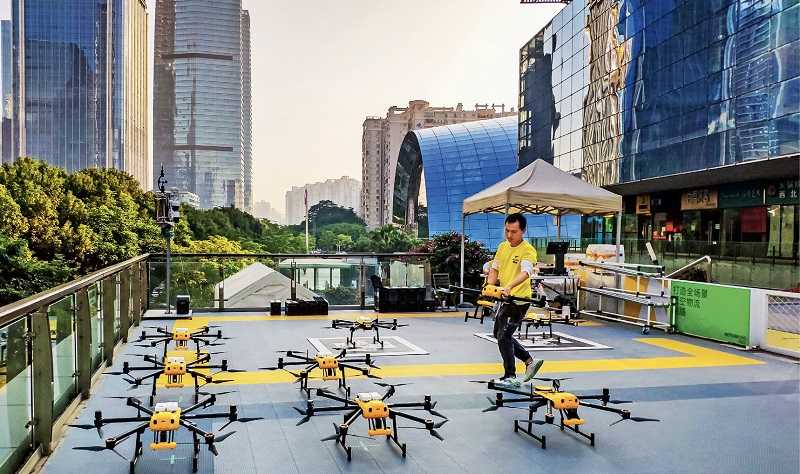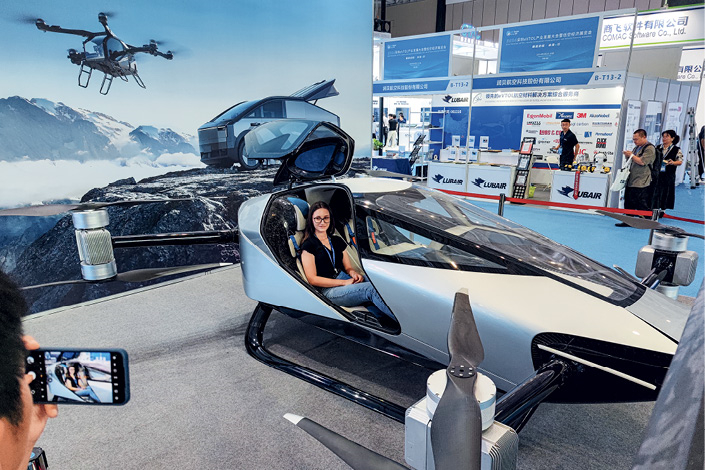In low altitude, an incredible airspace industry is taking shape.
As an economic concept, the low-altitude economy aims to utilize the unique resources of low-altitude airspace in a bid to develop general aviation or civilian non-airline flight, and energize the related industries from the sky to the ground.
The concept of low-altitude economy was first proposed by China, providing a theoretical contribution to the development of global general aviation. A common understanding is that low-altitude airspace is an equally important economic resource and engine of productivity as land and marine resources. Expanding low-altitude business will help China fully develop its general aviation.
With the innovative technology and products of general aviation, new types of aircraft, such as electric vertical takeoff and landing (eVTOL) vehicles or flying cars, have emerged, all of which are designed for urban air mobility (UAM) and further stimulating people’s imagination for future development. By utilizing such products and models in urban low-altitude airspace, it can solve the problem of urban and intercity traffic congestion.
As traffic jams are a global challenge, the proposal since its inception has attracted widespread attention from across the world. As China boasts many big cities, the UAM faces greater demands and prospects across the country.

A staff of Meituan operates drones at a delivery station in Nanshan District of Shenzhen on December 2, 2023.
Industrial Development
More than being just an economic concept, the low-altitude economy is also a developing industry. Besides, from an industrial point of view, it not only relates to the traditional general aviation, but involves a broader range of industrial business and economic category.
Expanding from general aviation to the low-altitude economy is an upgrade from an industry to an economic model. General aviation is the main industrial component of the low-altitude economy, while the low-altitude economy includes more investment and construction of general airports, vertiports, ground support facilities, and monitoring and flight service systems. It also integrates with other sections of the industrial chain, such as artificial intelligence, new energy, and aerospace satellite, and develops in collaboration with those emerging industries.
Based on general aviation technology, new products and innovative applications, the UAM has much room for development. By cooperating with a ground traffic system, it will bring a revolution to urban transportation modes and integrate the low-altitude economy into urban development. Then as it continues to develop, it will boom a wide range of applications and form a unique economic form both in the sky and on the ground.
A multi-layer flight network can meet the needs of different flying activities by utilizing the resources of low-altitude airspace. For example, it can be used in private flights, business flights, short-distance air transportation, urban air traffic, air emergency rescues, official and public service flights, operation flights, aviation sports, sightseeing, and flight entertainment.
To ensure vehicles can smoothly take off and land, more infrastructure should be built on the ground to complete the cycle of the whole industry. Such facilities include airports, vertiports, aviation parks, aviation towns, drone bases, flight camps, and aviation cultural tourism parks.
Supporting Policies
During recent years, there has been an increase of attention in many developed countries on the innovative development of general aviation. The U.S. Congress passed Advanced Air Mobility Coordination and Leadership Act in 2021, in which relevant government departments were urged to establish an interagency to promote the advanced air mobility (AAM). The European Union (EU) also launched the Horizon Europe program in 2020 to support UAM-related projects and enterprises.
As for China, the government has also supported the promotion of its low-altitude economy. In March 2024, the low-altitude economy was purposed in the annual government work report as the new growth engine to foster emerging industries..
The Communist Party of China said at the third plenary session of its 20th Central Committee in July 2024 that it will further integrated reform of the transportation system, and develop general aviation and the low-altitude economy.
In December 2023, relevant aviation departments solicited public feedback on draft regulations on the administration of airspace, which made institutional arrangements for the opening and utilization of low-altitude airspace.
In addition to government plans, many regions in China have also focused on developing their local low-altitude economy and making policies based on their region. For example, in China’s southern economic hub of Shenzhen, the government has issued many supportive policies to promote the building of a low-altitude economy center. At present, it has developed nearly 100 commercial trial routes for drone cargo flights in the city.
The Guangdong-Hong Kong-Macao Greater Bay Area, where Shenzhen is located, is one of the most congested areas in China. By promoting the collaboration between air and ground transportation, the UAM will be able to provide innovative solutions to address urban and intercity traffic problems.

A visitor tests an eVTOL at the 2024 Shenzhen eVTOL Expo on September 23, 2024.
Development Evidence from China
Although the development of traditional general aviation in China presently lags a few steps behind developed countries in Europe and America, thanks to the rapid advancement of its drone industry, the new form of low-altitude economy stands at the forefront of the globe.
China’s leading drone technology has laid a foundation for the development of eVTOL and UAM. At present, there are over 30 eVTOL enterprises in China, among which more than 10 companies have received millions of dollars from capital market. Companies, such as EHang, Autoflight, and Aerofugia, rank top companies of the global eVTOL industry.
China is also leading the way in airworthiness management. During the past two years, the Civil Aviation Administration of China issued the Type Certificate (TC), Production Certificate (PC), and Airworthiness Certificate (AC) for the manned eVTOL EH216-S produced by EHang, which is the first eVTOL to receive three qualified licenses in the world. In 2024, the administration issued a TC for a logistic eVTOL developed by Autoflight.
With the utilization of low-altitude airspace and improvement of the operation systems in the future, China’s low-altitude economy will enter a period of multi-tiered development, showing a trend of integration of operation, manufacturing, and services. It will also become a driving engine for the investment and construction of infrastructure, such as general airports, vertiports, monitoring and flight service systems, as well as the development of business supporting aviation, such as finance and insurance, aviation-themed cultural exhibitions, and scientific education, turning aviation into an industry worth trillions of dollars. 
GAO YUANYANG is director of General Aviation Industry Research Center of Beihang University.